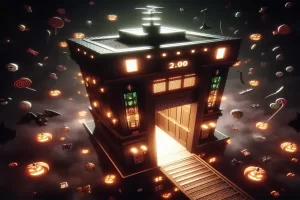Timed escape challenges in horror games are a thrilling fusion of suspense, strategy, and sheer terror. By introducing the pressure of a ticking clock, these challenges create an intense sense of urgency, forcing players to think quickly and act decisively while navigating environments fraught with danger. The added element of time pushes players into high-stakes situations where every second counts, heightening the emotional intensity and keeping the adrenaline pumping.
What makes these timed challenges so appealing is the unique blend of fear and excitement they generate. The fear of the unknown and the dread of what might be lurking around every corner are compounded by the constant reminder that there’s no time to waste. Whether it’s racing to escape a locked room, solving puzzles before time runs out, or outrunning a terrifying creature, these challenges offer an experience that is both mentally stimulating and heart-pounding.
In this blog, we’ll dive deeper into why these timed escape challenges are so captivating, exploring the thrill of racing against the clock and how they keep players on the edge of their seats, constantly balancing the urge to escape with the need to survive.
What Are Timed Escape Challenges?
Definition and Basic Concept
Timed escape challenges are a specific type of game mode in which players must complete objectives or escape from a dangerous situation within a set time limit. Unlike traditional puzzle or exploration games, where players can take their time to think and strategize, these challenges impose a ticking clock that adds a sense of urgency and pressure. In a timed escape scenario, players typically face a combination of tasks, such as solving intricate puzzles, finding hidden objects, or evading threats like monsters or environmental hazards, all while racing against time to meet the objective.
What sets timed escape challenges apart from other game modes is the necessity to complete everything before time runs out. The clock is constantly ticking, and if the players fail to escape or solve the puzzle within the allotted time, they lose the game, often facing a penalty or failure. This time-based pressure creates a thrilling dynamic, as players must balance their problem-solving skills with their ability to keep calm under duress.
The Role of Time in Creating Tension
Time plays a critical role in amping up the tension and fear in escape challenges. The constant awareness of the clock ticking down heightens anxiety and intensifies the player’s sense of urgency. As the deadline approaches, every action feels more significant, and the stakes are raised, pushing players to make quicker decisions—often without knowing if they are the right choices. The fear of failure becomes amplified as players realize that not only are they in a dangerous, high-stakes scenario, but there is a time limit that makes success seem almost impossible.
Psychologically, the pressure of time can cause players to feel overwhelmed and stressed. The finite nature of the challenge triggers the brain’s fight-or-flight response, forcing them to act quickly and often impulsively. This leads to heightened emotional responses, where every second spent deliberating or hesitating feels like a step closer to failure. The faster pace requires players to make decisions under stress, and the fear of making the wrong choice or getting trapped by a looming threat adds to the thrill of these challenges. The tension created by time limits not only elevates the gameplay experience but also enhances the fear factor, keeping players on edge until the very last moment
The Thrill of Racing Against Fear
Fear of Failing Under Pressure
The fear of failure is one of the most powerful emotions in timed escape challenges. As the clock counts down, players feel a constant pressure to succeed, and the possibility of failing adds an intense layer of fear. The idea of being caught, whether by a pursuing monster or by running out of time, amplifies this sense of anxiety. The looming threat of failure turns every decision into a high-stakes moment, where even a slight misstep can lead to disastrous consequences.
The tension is further heightened by the need to balance speed with accuracy. While rushing can save precious seconds, it often comes at the cost of making mistakes. Solving puzzles or navigating through dangerous environments requires quick thinking, but the fear of making the wrong choice or missing something important leads to heightened stress. The emotional stakes rise as players try to manage the growing pressure of the timer while facing the terror of what will happen if they fail. This creates a unique combination of fear and excitement, where success feels rewarding, but the consequences of failure can be downright terrifying.
Heightened Stakes and Immersion
The ticking clock in timed escape challenges doesn’t just raise the stakes—it also enhances immersion. As players race against the timer, the pressure of time makes them feel more deeply engaged with the game world. The sensation of urgency pulls them into the narrative and setting, making them feel as though they are genuinely trapped in a high-risk situation. The constant awareness of time running out forces players to be more present in the moment, pushing them to act quickly and think on their feet.
The contrast between calm exploration and the rush of urgency when time begins to run out also adds to the immersion. Early in the challenge, players might feel like they have all the time in the world to explore and gather information. But as the timer ticks closer to zero, the atmosphere shifts. The quiet, methodical pace of puzzle-solving turns into a frantic scramble, and the world around the player seems to close in. This shift in tempo mirrors the psychological effect of the timer, increasing the emotional investment in the outcome and making every second feel more crucial. The threat of time running out becomes more than just a gameplay mechanic—it becomes a fundamental part of the experience that amplifies both fear and immersion.
Escape Room Mechanics and Horror Themes
Puzzle-Solving Under Pressure
Timed escape challenges in horror games masterfully blend intricate puzzle-solving with the chilling atmosphere of their settings. Players are tasked with deciphering cryptic clues, unlocking doors, or piecing together fragmented narratives—all while being acutely aware of the ticking clock. The challenge is amplified by the unsettling environment, where every creak of the floor or flicker of light adds to the tension. The puzzles themselves are often designed to test not only players’ logic and reasoning but also their ability to remain composed under immense pressure.
Adding to the difficulty is the ever-present threat of danger. Players often find themselves solving puzzles while evading relentless enemies or navigating traps. The need to multitask—focusing on the puzzle while also being hyper-aware of their surroundings—heightens the overall stress. This dynamic creates a uniquely terrifying experience where every solved puzzle feels like a triumph against overwhelming odds, but the looming threats ensure the fear never truly subsides.
Environments Designed for Maximum Fear
The settings of timed escape challenges are carefully crafted to evoke fear and unease. From claustrophobic hallways in abandoned hospitals to the foreboding corridors of haunted mansions, these environments play a pivotal role in the overall horror experience. The confined nature of these spaces often leaves players feeling trapped, with limited options for escape. Dim lighting, ominous shadows, and eerie soundscapes further amplify the sense of dread, making the player’s journey as psychologically taxing as it is physically challenging.
Developers use environmental design to create a constant sense of danger. Tight spaces force players into close encounters with threats, while the oppressive atmosphere ensures that even moments of safety feel fleeting. Dark forests, for example, obscure visibility, leaving players unsure of what might be lurking just out of sight. Meanwhile, decrepit interiors filled with unsettling details—like broken furniture, bloodstains, or ominous messages scrawled on walls—tell stories of their own, adding layers of depth to the fear. These environments are not just backdrops but active components of the gameplay, intensifying the horror at every turn.
Timed Escape Challenges and Adrenaline
The Rush of Adrenaline
Timed escape challenges are designed to ignite an adrenaline rush, blending the thrill of high-stakes action with the terror of failure. The constant pressure of a ticking clock and the lurking threats create an environment of intense stress, activating players’ fight-or-flight responses. This physiological reaction leads to an increased heart rate, heightened senses, and a surge of energy, immersing players fully in the experience.
The fear of running out of time—or being caught by an enemy—keeps players on edge, ensuring that even simple tasks feel monumental. Every decision becomes crucial, and the rush to solve puzzles or find an escape route while under duress intensifies the gameplay. This heightened state of awareness not only makes the experience more thrilling but also deepens the connection between the player and the game world, as every second counts.
The Impact of Escape Sequences
Successfully completing a timed escape challenge delivers a powerful emotional payoff. The moment of triumph—escaping just as the timer hits zero or evading a final enemy—brings a wave of exhilaration and relief. This emotional release is a direct result of the high tension experienced throughout the challenge, making the success feel all the more rewarding.
The combination of fear, urgency, and eventual accomplishment creates a memorable gameplay moment. Players feel a sense of mastery, having conquered their fears and outsmarted the game’s challenges. This balance of stress and satisfaction is a hallmark of great timed escape challenges, offering an adrenaline-fueled experience that keeps players coming back for more.
Psychological Aspects of Racing Against Fear
The Role of Fear and Time Pressure in Cognitive Functioning
Timed escape challenges in horror games put players’ cognitive skills to the test by combining fear and time pressure. This dual stressor can significantly impact decision-making, as players must think quickly to solve puzzles or evade threats. The presence of a ticking clock amplifies anxiety, often leading to rushed or panicked actions that may hinder progress rather than help.
Under time constraints, players experience heightened mental strain, which can impair their ability to think critically or creatively. This phenomenon, known as “time-pressure stress,” creates a unique challenge, as players must balance their instinct to act quickly with the need for precision. These moments force players to prioritize their decisions and focus intensely, making every choice feel crucial to survival.
The Fight-or-Flight Response
Timed escape challenges are masterful at triggering the fight-or-flight response, a physiological reaction to perceived danger. When faced with fear-inducing scenarios and the pressure of a countdown, players often shift into a heightened state of instinctive action. Rather than relying on careful planning, they make rapid decisions to escape or confront threats head-on.
This response adds a layer of realism to the gameplay, as players feel immersed in the urgency of the situation. The fear of running out of time or being caught forces them to push through their apprehension, often leading to surprising moments of bravery and quick thinking. By tapping into this primal reaction, timed escape challenges offer an intense, visceral experience that keeps players engaged and on edge.
Conclusion
Timed escape challenges in horror games represent a masterful blend of tension, fear, and exhilaration. The constant race against the clock, coupled with the pressure of navigating terrifying environments and solving intricate puzzles, creates an unforgettable gaming experience. These mechanics tap into primal emotions, amplifying suspense and immersing players in the fear and urgency of survival.
What makes these challenges truly special is their ability to balance fear and excitement. Players are not just terrified—they’re also thrilled by the adrenaline rush of narrowly escaping danger or solving a puzzle in the final moments. This unique combination keeps players engaged, encouraging them to replay and relive the tension.
If you’ve never experienced the pulse-pounding intensity of a timed escape challenge, now is the perfect time to dive in. Explore the world of Roblox horror games or other titles that feature these heart-pounding mechanics. Test your wits, confront your fears, and savor the adrenaline rush as you race against time. You might just find yourself hooked on the thrill!




